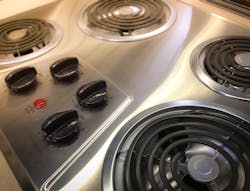When I first received the agenda for this year’s IAEI Eastern Section Meeting and noticed a program for appliance connections, I admit I was a bit skeptical of the topic at first. However, when Michal Hofkin, an electrical inspector in the Philadelphia area, presented the program, he immediately caught my attention, making me realize that we take these connections for granted far too often. As a result, I want to share a review of these practices when applying the 2017 NEC.
This article will predominately focus on the requirements located in Art. 422; however, some of the requirements in Art. 210 will also be covered. The first thing to discuss is the reorganization of the requirements for ground-fault circuit-interrupter (GFCI) protection for appliances into a list format located in Sec. 422.5(A) and (B). This is interesting because GFCI protection is intended for personal shock protection not equipment protection — and is typically addressed in Sec. 210.8, which covers mostly receptacle outlets where end-use equipment is plugged in. Although the GFCI requirements in Sec. 422.5 are for specific equipment, the goal is to protect persons from shock hazards that typically result from end-of-life failures or equipment abuse.
Section 422.5(A) lists the items to be protected as:
1. Automotive vacuum machines provided for public use.
2. Drinking water coolers.
3. High-pressure spray washing machines — cord-and-plug connected.
4. Tire inflation machines provided for public use.
5. Vending machines.
A new 422.5(B) specifies that this protection be readily accessible, listed, and be in one or more of the following locations:
1. Within the branch circuit overcurrent device.
2. A device or outlet within the supply circuit.
3. An integral part of the attachment plug.
4. Within the supply cord and not more than 12 in. from the attachment plug.
5. Factory installed within the appliance.
There are some interesting items to consider here. First, Sec. 210.8(D) requires that dishwashers have GFCI protection. This places an equipment requirement in an area of the NEC that typically covers receptacles, not equipment. Second, notice the requirements above that specify public use. Does that mean that the public should be protected from shock hazards, and people who work with this equipment in other-than-public areas should not be afforded the same protection? Don’t worry, if the 2020 NEC is accepted as currently proposed, all the equipment requirements (including sump pumps) will be relocated to Art. 422 — and the references to public use are being removed.
As we move into branch-circuit sizing and overcurrent protection, there are varying requirements that include both Art. 422 and Art. 210. One of the important factors here is whether the NEC or the appliance installation instructions mandate the use of an individual branch circuit. The only mandatory use of an individual branch circuit in Art. 422 is Sec. 422.12 for central heating equipment. Other appliances may be supplied by an individual branch circuit, and, if so, it must be sized to at least that of the nameplate rating of the appliance. If it’s motor operated, you must also comply with the requirements of Art. 430.
One other consideration would be continuous loading and the requirement of a circuit rating at least 125% of the appliance nameplate ampacity if the appliance would be operated for a period of 3 hours or more at that ampacity. One additional requirement for individual branch circuits would be if the branch circuit is supplying household ranges or cooking appliances — then the adjusted values located in Table 220.55 are permitted to be used. Section 210.23 delineates this basic sizing requirement by limiting any utilization equipment that is not fastened in place to 80% of the circuit rating and utilization equipment that is fastened in place to 50% of the rating of the circuit if other loads are served with the same circuit. One important detail to note is the difficulty for a designer, installer, or enforcer to obtain compliance with the 80% rule when in fact they have no control over what the end user will plug into a receptacle outlet.
Appliances also require overcurrent protection. Here again, we rely upon any maximum ratings that may be supplied on the appliance nameplate or installation instructions. In addition, Sec. 422.11(E) provides guidance for overcurrent device ratings when the nameplate does not provide the information. This basic guidance is for a maximum of 20A where the appliance has a rating of 13.3A or less and 150% of the appliance ampacity where over 13.3A and the next standard size rule can be used for this application.
The next requirement to look at is the use of flexible cords for the connection of appliances. Section 422.16 permits the use of flexible cords to minimize the transmission of noise or vibration, or to permit ready removal for maintenance or repair. In applying either of these allowances, the manufacturer’s instructions must be reviewed to assure that the appliance is intended for the use of flexible cord connections. In addition, the type of flexible cord and conductors contained within need to be rated for the environment and ambient temperature that they could be exposed to. Section 422.16(B) defines specific appliance type requirements as follows:
• In-sink waste disposers must have a grounding type attachment plug on a cord that is between 18 in. and 36 in. long, and the associated receptacle must be accessible and not expose the cord to physical damage.
• Built-in dishwashers and trash compactors must have a grounding type attachment plug, with a cord length of 3 ft to 4 ft for a trash compactor and 3 ft to 6.5 ft for a dishwasher. The receptacle for a trash compactor can be either in the space used by the compactor or in the adjacent space whereas the receptacle for a dishwasher must be placed in the adjacent space as dictated by the product standard for household dishwashers (UL 749). These receptacles must also be accessible without exposing the cord to physical damage.
• Wall-mounted ovens or counter-mounted cooking units are permitted to use cord and plug connections, provided the receptacle and plug assemblies have a temperature rating sufficient for the space where they are located.
• For range hoods, where a grounding-type attachment plug is used, the cord must be between 18 in. and 48 in. in length. The receptacle must be accessible without exposing the cord to physical damage and the receptacle must also be supplied by an individual branch circuit.
As stated above, the use of flexible cord assemblies for the connection of appliances may be permitted based on the installation instructions that are supplied by the appliance manufacturer. That leads us into the requirements for appliance disconnecting means. As with other electrical equipment, the ability to remove all sources of power from an appliance is essential for safety purposes. Section 422.31 provides requirements for permanently connected appliances. Parts (A) and (B) permit the use of the branch-circuit overcurrent device, provided the overcurrent device is either in sight from the appliance or capable of being locked in accordance with Sec. 110.25. Section 422.31(C) addresses motor-operated appliances and references Sec. 430.109/Sec. 430.110 for the type and rating of the disconnect. This section also allows the disconnecting means to be either in site from the appliance or be capable of being locked in the open position in accordance with Sec. 110.25. One thing to note here is that Art. 430 requires the disconnecting means to be in sight from a motor whether it can be locked in the open position or not — this may cause a difference of opinion in the field.
Section 422.33 covers flexible cords and attachment plugs used as the appliance disconnecting means. Section 422.33(A) permits a flexible cord and attachment plug to serve as the disconnecting means, provided it is accessible after installation, and, more importantly, if it is a “factory installed” part of the appliance. If both criteria are not met, then you must go back to the requirements of Sec. 422.31. The long-standing practice of placing a receptacle behind an electric range and accessing it by removing the drawer is covered in Sec. 422.33(B). Although this is permitted, and it provides a good installation practice for the interchange of appliances, it may be advisable to also provide a disconnecting means that complies with Sec. 422.31, as many times these receptacles are not easily accessed even with the bottom drawer removed.
The last item to be covered is the use of appliance “Unit Switches” as the appliance disconnecting means as covered in Sec. 422.34. To be used as the disconnecting means, the unit switch must be marked “ON” and “OFF,” and it must disconnect all ungrounded conductors. In addition, based on the occupancy type, a secondary disconnecting means is required. In multifamily dwellings, the second disconnecting means must be within the unit or on the same floor as the appliance. This would indicate that the disconnecting means be located in a panelboard within the dwelling unit or a common area panelboard on the same floor, although neither of these is spelled out very clearly. In two-family dwellings, the additional disconnecting means could be either inside or outside of the unit and can control other loads. This would indicate the use of a feeder overcurrent device would comply with the disconnect rules, although that too is not completely spelled out in the Code rules. In single family dwellings, the second disconnect could be the service disconnect, and in all others a branch circuit switch or circuit breaker that is readily accessible when servicing the appliance can be used.
In recent years, a popular trend has been to add flexible cords to appliances to permit their interchange without the necessity of having a qualified person available for the disconnection and reconnection of the appliance. Hopefully, this article will help in providing some guidance as to when such an installation is permitted by the NEC.
Rogers is the owner/operator of Bay State Inspectional Agency, Vineyard Haven, Mass. He is an active instructor for IAEI, the wiring inspector for the town of Oak Bluffs, and the chair of NEC Code-Making Panel 4. He can be reached at [email protected].
About the Author
Jim Rogers
Owner
Jim Rogers has more than 50 years of experience in the electrical profession is a licensed journeyman and master electrician, a nationally certified electrical inspector, and an associate electrical engineer. He has managed the Massachusetts Electrical Board and serves on both state and national code committees. He is currently the electrical inspector for the town of Oak Bluffs, Mass., and operates a private inspection and investigation company, Bay State Inspectional Agency.
Rogers represents the International Association of Electrical Inspectors (IAEI) as the chair of NEC Code Making Panel (CMP) 4 for the National Fire Protection Association (NFPA), which has purview over photovoltaic systems and other alternative energy systems. Prior to being assigned to CMP 4, in 2000 he was the alternate to Andy Cartel on CMP 12. He also serves on the NFPA 303 Committee on Boatyards and Marinas. Rogers currently instructs for IAEI. He has previously taught for the International Brotherhood of Electrical Workers (IBEW) and served as an adjunct professor at the Benjamin Franklin Institute of Technology in Boston.
In addition, he has over 40 years of experience in the fire service and retired for the fire service with the rank of assistant chief, as well as serving as the department investigator and team leader for the County Fire Investigation Team. Rogers is a nationally certified fire investigator and certified fire and explosion investigator, as well as a state-certified fire inspector. He also has a bachelor’s degree in fire science from the University of Maryland.


